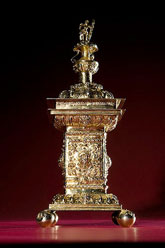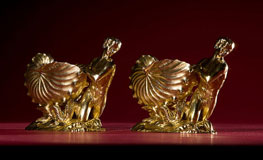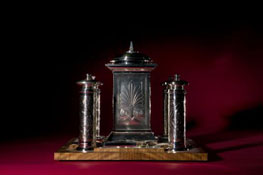The Salt Collection
The importance of salt, especially hundreds of years ago, cannot be overstated. Without salt, food would have been unpalatable and sometimes, if gold was not available, salt became the accepted token of exchange. Thus saltcellars became a status symbol; those who could afford salt kept it in a grand container. When entertaining, the saltcellar would be placed near the host to symbolise his wealth and importance. Guests were seated above or below the salt according to their social standing.
As the fundamental importance and value of salt lessened with the advent of tin cans, improvements in farming methods and better housing, saltcellars became less symbols of social status and more aesthetically pleasing ornaments.
Origins of The Salt Collection
The Company has benefited from the heritage of generous gifts from Liverymen and inspired commissions made by the Court over many generations. Salters’ Hall is an obvious home for a national collection of domestic saltcellars or salts and it may be viewed by arrangement by anyone with a special interest. As guardians of this heritage, it has been the policy of the Company that while giving priority to supporting the work of the Salters’ Institute and other charities, the Salt Collection should be continually built upon. Here is a selection of some key pieces and their significance to the Company.
Examples from the Salt Collection
Standing Salt, gilt, 1589
Ceremonial salts with a geometrical design were very popular in the later Middle Ages and early Renaissance. This salt, purchased in 1953, is probably the most important piece of the Company's collection. The complicated, intricate design was common at a time when the more decorative the salt, the higher one’s perceived social standing. The warrior on top of the salt was symbolic of the gallantry of the Host and the jewelled dresses were painted by goldsmith Nicolas Hilliard.

Paul Storr, Set of Four, gilt, 1811-13
This pair of tritons each towing a seashell through waves is part of a set of four made by gifted silversmith Paul Storr for Rundell, Bridge and Rundell. These salts appeared on the BBC's Antiques Roadshow and were subsequently bought at auction by The Salters' Company. It is thought that these salts were designed by William Theed, who joined Rundell, Bridge and Rundell following employment at Wedgwood. The design was very successful and many variants were created throughout the nineteenth century. Another pair made in 1851 with a slightly different design was given to the Company by Lord Palumbo of Walbrook, a Liveryman.

Hourglass
Donated by Samuel John Blackwell, Master 1895-1896. Hallmarked 1895 by Garrard & Co.

The Loving Cup, gilt, 1866
This silver Loving Cup was commissioned by the Company in 1866 and features the Salters' coat of arms. It is used in the Ceremony of the Loving Cup, a key component of all Company dinners and banquets and part of an ancient ritual practised by Livery Companies for centuries.

Millennium Salt, gilt, 2000
Designed by Rod Kelly, this piece was commissioned by the Company to commemorate the Millennium. The salt is square in plan, and was loosely inspired by the Salters' Renaissance Salt of 1589 (frontispiece). The snow leopards have inlaid gold details. There are four round pepper mills, one at each corner, on a base of black stained walnut.








